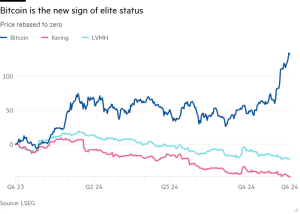How Ozempic is transforming your gym
Unlock the Editor’s Digest for free
Roula Khalaf, Editor of the FT, selects her favourite stories in this weekly newsletter.
Hold tight to your free weights — the Ozempic revolution is coming to a gym near you.
The runaway success of “GLP-1” weight loss and diabetes drugs, which also include Wegovy and Zepbound, is hard to overstate. Sales are expected to approach $50bn this year, making them the top-selling class of drugs worldwide. That is despite global shortages, high prices and the fact that the drugs are largely available only in injectable form so far. Sales are expected to more than double to $130bn by 2030 and could soar higher if the makers win permission to sell them as a preventive tool.
For pharma groups Novo Nordisk and Eli Lilly, soon to be joined by others, this is fabulous news. For others, it is likely to be really bad. Diet company WeightWatchers recently changed chief executives as it struggles to adjust, and soft drink, beer and snack company shares have been on a wild ride as investors try to figure out who will be hurt the most when consumers taking the drugs eat healthier food and fewer calories overall.
For gyms and health clubs, the impact is going to be huge but complicated for an industry that is still rebuilding after Covid. The pandemic put a quarter of US fitness centres out of business and reshaped commuting and exercise patterns. Weight-loss drugs are likely to supercharge a consumer rush towards strength training equipment that has been gaining force for more than a decade, and many gyms are still ill-prepared.
Ten years ago, most health club floors were seas of treadmills, elliptical machines and stationary bikes, with fixed weight machines along the edges along with a free weight area geared towards power lifting, mostly by men. But the pandemic and concurrent rise of apps and YouTube videos that gave people access to personalised fitness routines has made that configuration all but obsolete.
Customers still use treadmills but both sexes now seek out a wider range of strength training equipment, including barbells, dumbbells, medicine balls and the like. Clubs, seeking to boost membership, have also leaned into the social aspects of in-person fitness, from group classes and personal trainers to cafés and hang-out areas.
Gyms are pushing their stair climbers and fixed weight machines to the periphery and replacing them with open space for body-sculpting classes, free weights and individual training sessions.
“We’re seeing a greater demand for space for strength,” Colleen Keating, CEO of Planet Fitness, one of the largest listed gym groups, told analysts in August. Even Peloton, famous for its cardio-intensive bikes, is testing an app focused on strength training.
The shift takes time and money. The now less-popular cardio machines are often sold on multiyear leases, while strength training equipment generally requires an upfront investment. The delay is leading to uneven usage and customer complaints at clubs that have not made the shift.
Weight-loss drugs will exacerbate the pressure. As the drugs gain acceptance, fewer people are likely to rely on exercise as their primary weight loss tool and the drugs’ side effects, nausea and intestinal distress, can make high-impact cardio activities uncomfortable.
However, GLP-1 users still need the gym. Studies suggest that the drugs cause significant muscle loss along with fat, leading to problems with balance and mobility as well as saggy skin sometimes dubbed “Ozempic butt”.
Strength training seems to be the answer not just for GLP-1 users but everyone else. A growing body of medical literature suggests strength training cuts mortality, particularly for women, while also helping to prevent osteoporosis and relieving the symptoms of depression.
“It’s gone from being health and fitness to health and wellness, which is a lot more holistic” says Eleanor Scott, a partner on PwC’s leisure strategy team.
Foot traffic to popular US gym chains Crunch Fitness and EoS Fitness is up by double-digits year on year, according to data provider Plaicer.ai. Planet Fitness has added 2.7mn members since the start of 2023 and improved its profit margins.
For all of them, the combination of strength training with prevention creates a chance to win, or win back, older customers still wary of gyms post-Covid. Although 80 per cent of baby boomers participate in fitness activities, just 42 per cent belong to a gym, compared to nearly three-quarters of active Gen Zers and millennials, according to ABC Fitness. But growth will not follow if newcomers end up fighting the regulars for access to the dumbbells.
Follow Brooke Masters with myFT and on X
#Ozempic #transforming #gym







